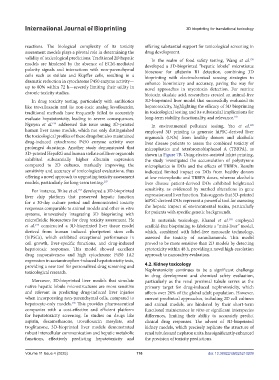Page 124 - v11i4
P. 124
International Journal of Bioprinting 3D bioprinting for translational toxicology
reactions. The biological complexity of its toxicity offering substantial support for toxicological screening in
assessment models plays a pivotal role in determining the drug development.
validity of toxicological predictions. Traditional 2D hepatic In the realm of food safety testing, Wang et al.
130
models are hindered by the absence of ECM-mediated developed a 3D-bioprinted “hepatic lobule” microtissue
polarity signals and interactions with non-parenchymal biosensor for aflatoxin B1 detection, combining 3D
cells such as stellate and Kupffer cells, resulting in a bioprinting with electrochemical sensing strategies to
dramatic reduction in cytochrome P450 enzyme activity— enhance biomimicry and accuracy, paving the way for
up to 80% within 72 h—severely limiting their utility in novel approaches in mycotoxin detection. For marine
chronic toxicity studies. biotoxin okadaic acid, researchers created an animal-free
In drug toxicity testing, particularly with antibiotics 3D-bioprinted liver model that successfully evaluated its
like trovafloxacin and its non-toxic analog levofloxacin, hepatotoxicity, highlighting the efficacy of 3D bioprinting
traditional methods have frequently failed to accurately in toxicological testing and its substantial implications for
evaluate hepatotoxicity, leading to severe consequences. long-term stability, functionality, and relevance. 197
Nguyen et al. addressed this issue using 3D-printed In environmental pollutant testing, Yao et al.
194
189
human liver tissue models, which not only distinguished employed 3D printing to generate hiPSC-derived liver
the toxicological profiles of these drugs but also maintained organoids (DOs) from healthy donors and alcoholic
drug-induced cytochrome P450 enzyme activity over liver disease patients to assess the combined toxicity of
prolonged durations. Another study demonstrated that microplastics and tetrabromobisphenol A (TBBPA), as
3D-printed HepaRG and human stellate cell liver organoids shown in Figure 7B. Using electro-assisted inkjet printing,
exhibited substantially higher albumin expression the study investigated the accumulation of polystyrene
compared to 2D cultures, markedly improving the microplastics in DOs and the effects of TBBPA. Results
sensitivity and accuracy of toxicological evaluations, thus indicated limited impact on DOs from healthy donors
offering a novel approach to upgrading toxicity assessment at low microplastic and TBBPA doses, whereas alcoholic
models, particularly for long-term testing. 207 liver disease patient-derived DOs exhibited heightened
For instance, Bhise et al. developed a 3D-bioprinted sensitivity, as evidenced by marked alterations in gene
153
liver chip platform that preserved hepatic function expression and liver function. This suggests that 3D-printed
for a 30-day culture period and demonstrated toxicity hiPSC-derived DOs represent a powerful tool for assessing
responses comparable to animal models and other in vitro the hepatic impact of environmental toxins, particularly
systems, innovatively integrating 3D bioprinting with for patients with specific genetic backgrounds.
microfluidic bioreactors for drug toxicity assessment. He In materials toxicology, Khanal et al. employed
198
et al. constructed a 3D-bioprinted liver tissue model scaffold-free bioprinting to fabricate a “mini-liver” model,
195
derived from human induced pluripotent stem cells which, combined with label-free nanoscale technology,
(hiPSCs), which exhibited exceptional performance in assessed the toxicity of nanodiamonds. This model
cell growth, liver-specific functions, and drug-induced proved to be more sensitive than 2D models by detecting
hepatotoxic responses. This model showed excellent cytotoxicity within 48 h, providing a novel high-resolution
drug responsiveness and high cytochrome P450 1A2 approach to nanosafety evaluation.
expression in acetaminophen-induced hepatotoxicity tests,
providing a new tool for personalized drug screening and 4.2. Kidney toxicology
toxicological research. Nephrotoxicity continues to be a significant challenge
in drug development and chemical safety evaluation,
Moreover, 3D-bioprinted liver models that simulate particularly as the renal proximal tubule serves as the
native hepatic lobule microstructures are more sensitive primary target for drug-induced nephrotoxicity, which
and relevant in predicting drug-induced liver injuries affects over 20% of the global adult population. However,
when incorporating non-parenchymal cells, compared to current preclinical approaches, including 2D cell cultures
hepatocyte-only models. This provides pharmaceutical and animal models, are hindered by their short-term
196
companies with a cost-effective and efficient platform functional maintenance in vitro or significant interspecies
for hepatotoxicity screening. In studies on drugs like differences, limiting their ability to accurately predict
aspirin, dexamethasone, trovafloxacin mesylate, and clinical drug responses. The advent of 3D-bioprinted
troglitazone, 3D-bioprinted liver models demonstrated kidney models, which precisely replicate the structure of
robust intercellular communication and hepatic metabolic renal tubules and nephron units, has significantly enhanced
functions, effectively predicting hepatotoxicity and the precision of toxicity predictions.
Volume 11 Issue 4 (2025) 116 doi: 10.36922/IJB025210209

